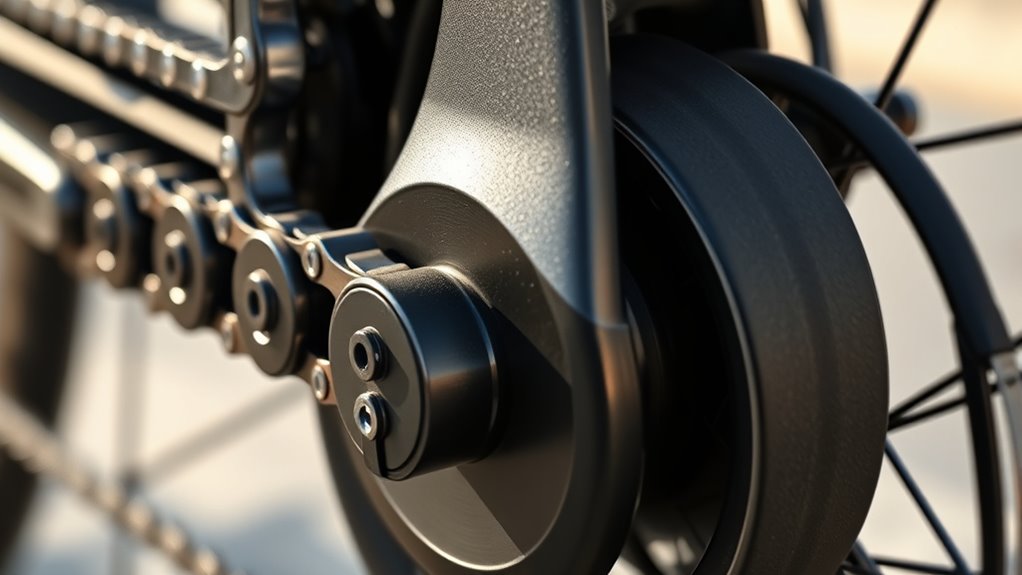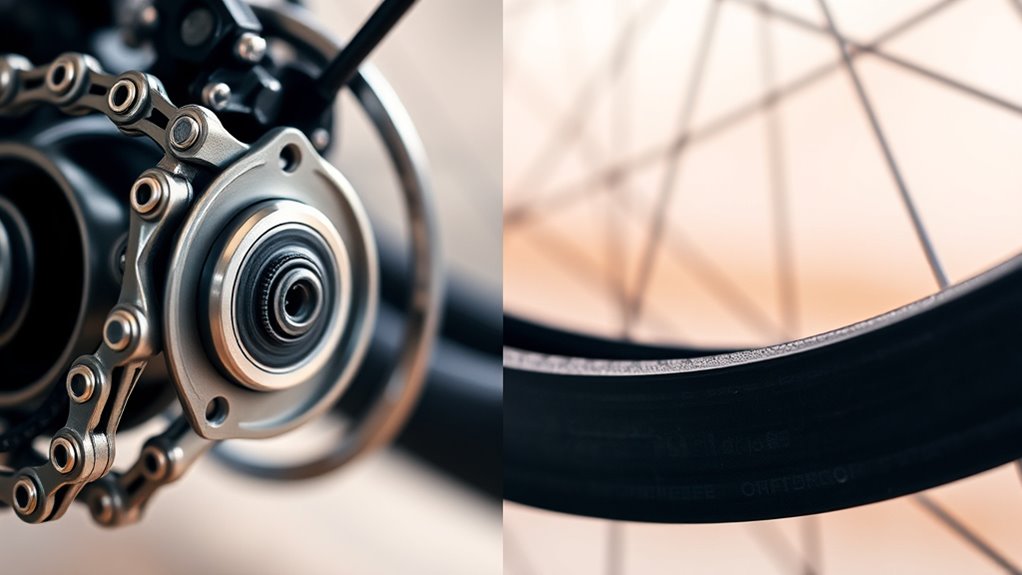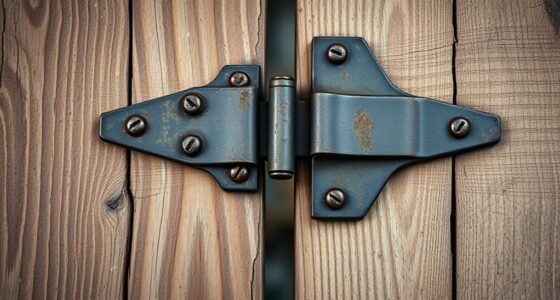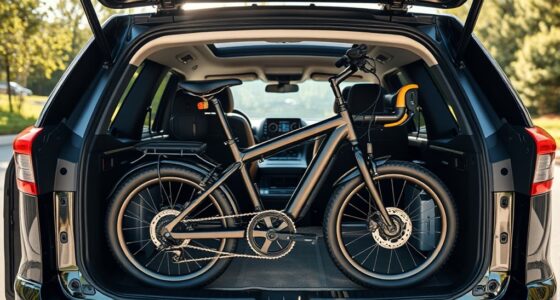Choosing between a chain or belt drive on your compact e-bike depends on your riding style and maintenance preferences. Chains offer more gear flexibility, handle higher torque, and suit varied terrains, but require regular lubrication and upkeep. Belts need less maintenance, are cleaner, and provide reliable, steady performance, especially for straightforward rides. If you want a simple, low-maintenance setup, a belt might be best; for versatile riding, a chain could be more suitable. To discover which option matches your needs, keep exploring the options.
Key Takeaways
- Chains offer greater gear ratio flexibility and are better suited for varied terrains and intense riding conditions.
- Belts require less maintenance, resist rust, and are ideal for riders seeking a hassle-free, clean setup.
- Chains handle higher torque loads and support customization, making them preferable for more dynamic riding styles.
- Belt drives demand precise alignment and are less tolerant of misalignment, suitable for straightforward, consistent use.
- Overall, the choice depends on riding preferences: chains for versatility and performance, belts for low maintenance and simplicity.

Have you ever wondered whether a chain or a belt is better for your compact e-bike? The choice largely depends on your riding style and maintenance preferences, especially when considering factors like gear ratios and maintenance frequency. Chains are known for their versatility, allowing a wide range of gear ratios, which means you can shift smoothly between speeds and tackle various terrains with ease. However, they require more frequent maintenance to keep them running smoothly. Regular lubrication and cleaning are necessary to prevent rust and ensure peak performance. If you don’t want to spend time on upkeep, chains might feel like a hassle, but they do offer durability and the ability to handle higher torque loads, making them suitable for more intense riding conditions.
On the other hand, belts are generally low-maintenance and cleaner, making them appealing if you prefer a hassle-free experience. Unlike chains, belts don’t need lubrication, and they don’t rust or stretch as easily over time. This means less frequent maintenance, which can be a big advantage if you ride often or don’t want to worry about constant upkeep. However, belts come with a more limited range of gear ratios because they’re less flexible when it comes to changing gears. This can restrict your options if you’re looking for precise control over your speed or riding conditions. Belt drives also tend to be less tolerant of misalignment, so installation needs to be done carefully for peak performance.
When choosing between a chain and a belt, consider how frequently you ride and how much maintenance you’re willing to do. If you enjoy tinkering, ride on varied terrains, and want the ability to customize gear ratios for different situations, a chain might suit you better. But if you prefer a straightforward, clean setup with less maintenance, a belt could be the smarter choice. Remember that gear ratios are more flexible with chains, allowing you to adjust your riding experience, but this comes with the trade-off of increased upkeep. Conversely, belts are more consistent and reliable but might limit your gear options. Ultimately, your riding habits and maintenance preferences will guide you toward the best option for your compact e-bike, ensuring a smooth and enjoyable ride tailored to your needs.
Frequently Asked Questions
How Does Chain Maintenance Compare to Belt Maintenance?
You’ll find chain maintenance requires regular lubrication to prevent rust and guarantee smooth operation, which can be time-consuming. Chains have higher durability factors, but they need frequent cleaning and tension adjustments. Belt maintenance is simpler, needing less lubrication and less frequent checks. Overall, belts are low-maintenance and more durable over time, whereas chains demand more attention but can handle rougher conditions better.
Are Belts More Eco-Friendly Than Chains?
Yes, belts are more eco-friendly than chains because they offer sustainability benefits by reducing the need for frequent replacements and maintenance, which lowers waste. Belts produce less environmental impact overall since they don’t require lubrication and last longer, decreasing resource use. By choosing a belt drive, you contribute to a greener environment and enjoy a cleaner, quieter ride with less maintenance.
Which System Offers Better Resistance to Dirt and Debris?
Belt drives typically offer better resistance to dirt and debris than chains, making them ideal for messy conditions. They don’t rust or corrode easily, so debris protection keeps them running smoothly longer. Chains, on the other hand, can trap dirt and require more maintenance to prevent wear and rust. If you ride in rugged or muddy environments, a belt system provides superior dirt resistance and less hassle with debris buildup.
Can I Upgrade My E-Bike From Chain to Belt or Vice Versa?
You can’t easily upgrade your e-bike from chain to belt or vice versa because they have different frame and drivetrain requirements. If you’re considering durability and cost, belts generally offer better gear durability and lower maintenance costs but might require a more expensive initial investment. Chains are cheaper upfront but need more frequent repairs and adjustments. Think about your riding habits and budget before making a switch.
How Do Noise Levels Differ Between Chains and Belts?
You’ll notice that belt drives are considerably quieter, with sound levels often 50% lower than chains. In noise comparison, belts produce a soft, smooth hum, making for a more peaceful ride, especially in urban environments. Chains, however, tend to generate more noise due to metal-on-metal contact, which can be louder and less pleasant. If quietness matters most, a belt drive offers a clear advantage for your e-bike experience.
Conclusion
So, whether you prefer the low-maintenance charm of a belt or the rugged reliability of a chain, remember—your choice might just decide how much you enjoy fixing your bike instead of riding it. Ironically, the smoother, quieter belt could leave you longing for the days when chain repairs kept your hands busy. Whichever you pick, just hope it doesn’t break down right when you’re racing to beat the rain—because then, it’s all about the fun of fixing, not riding.









